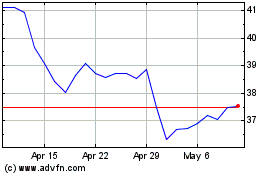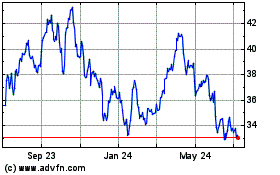Halliburton Swings to Profit -- Update
October 19 2016 - 12:09PM
Dow Jones News
By Anne Steele
Halliburton Co. posted a surprise small profit for the third
quarter after a year of losses during a protracted energy
downturn.
Executives for the oil-field services provider said Halliburton
was able to eke out a $6 million profit because its U.S. energy
company customers started to return to drilling this summer as
crude prices marched back toward $50 a barrel.
Dave Lesar, chief executive of the Houston-based company, said
he was pleased with the results "given the devastation our industry
has faced over the last two years."
The slow but steady return to oil patches across the U.S. will
continue as long as crude prices hover around $50 a barrel or
higher, a trend Mr. Lesar expects to hold.
"Our customers are smart and they see 2017 as getting better,"
he said.
Over all for the quarter ending in September, Halliburton posted
a profit of $6 million, or a penny a share, compared with a
year-earlier loss of $54 million, or 6 cents a share. Total revenue
plunged 31% to $3.83 billion. Analysts polled by Thomson Reuters
had projected a loss of 6 cents a share on $3.9 billion in
revenue.
Shares in the company, which are up 38% so far this year, rose
4.8% to $49.33 in midmorning trade.
While North American business is generally improving, the
company said international drilling efforts are still stymied. The
rig count outside of the U.S. is expected to bottom out during the
first half of next year, Halliburton President Jeff Miller told
investors and analysts Wednesday on a conference call.
The third quarter was particularly bad for energy companies
operating in Mexico, Venezuela, Australia and Indonesia, Mr. Miller
said, citing a 15-year low for the rig count in Latin America.
It was also the first period during which Halliburton has been
relieved of hefty charges related to its failed tie-up with rival
Baker Hughes Inc., another Houston-based oil-field services
company. That merger, initially valued at $35 billion when it was
first proposed in 2014, failed last May amid intense global
regulatory scrutiny.
When oil was trading around $100 -- double what it is today --
significant inefficiencies were covered up across the industry,
executives said. For instance, demand for labor and equipment was
so great that truck drivers hauling oil-field equipment regularly
made six-figure salaries, and rates to rent drilling rigs
skyrocketed.
But two years of plunging then languishing oil prices forced
Halliburton to slash the price tags of its goods and services to
energy companies. Now Halliburton wants to claw back some of those
price concessions.
Despite its failed merger attempt, Halliburton has the largest
market share of any oil-field services company in the U.S., a
position it is willing to cede in favor of getting paid the higher
prices it needs to operate profitably. Negotiating higher prices
for its services is like being in a "barroom brawl" with customers,
Mr. Miller said.
But he argued that Halliburton has been able to help shale
drillers boost output from wells using fewer chemicals, which is
making fields across the Permian Basin in West Texas economic at
lower oil prices. Even American oil companies that don't hold
leases in core areas considered to have the best geology and
prospects for oil are finding more.
"Our job is to help extend the definition of core," he said.
North America results -- which have dragged lately amid
energy-market volatility -- improved in the third quarter, but
sustained meaningful recovery depends on oil prices staying over
$50. The business, which is the contributor to Halliburton's top
line, rose 9% sequentially, and operating results improved by $58
million, representing margin improvement.
"This is a step in the right direction as we work to regain
profitability in North America," Mr. Lesar said.
In all, revenue in North American operations was down 33% from a
year ago.
Last quarter Halliburton predicted a U.S. oil patch turnaround
was on the horizon, but Wednesday executives sounded a note of
caution that the fourth quarter could slow down due to holiday and
seasonal weather-related downtime before activity picks back up in
early 2017.
"We remain cautious around fourth quarter customer activity,"
Mr. Lesar said. "However, it does not change our view that things
are getting better for us and our customers."
Anne Steele contributed to this article.
Write to Anne Steele at Anne.Steele@wsj.com
(END) Dow Jones Newswires
October 19, 2016 11:54 ET (15:54 GMT)
Copyright (c) 2016 Dow Jones & Company, Inc.
Halliburton (NYSE:HAL)
Historical Stock Chart
From Mar 2024 to Apr 2024

Halliburton (NYSE:HAL)
Historical Stock Chart
From Apr 2023 to Apr 2024
